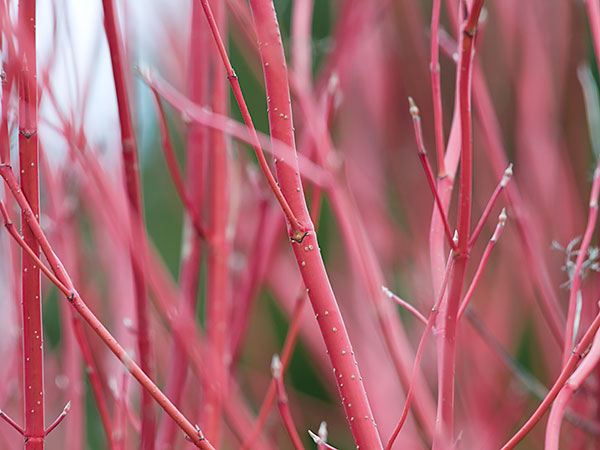
Unusually mild weather might cause some buds on flowering shrubs to bloom prematurely. These flower buds will not rebloom in spring, but there will be enough of the unopened buds to flower at their appropriate time. Forsythia, viburnum, flowering quince, weigela, and magnolia will often bloom sporadically during warm periods in late fall or early winter.
Continue to cut branches for forcing indoors. Branches with interesting foliage as well as flowering branches can be forced. Prune carefully, using proper pruning techniques and cutting off only those branches that are not essential to the plant’s basic shape. Branches should be at least 1 foot long, full of fat flower buds, and cut on a day above freezing. Lay the branches in a bathtub filled with room-temperature water. Make crosscuts in stem ends or smash woody ends with a hammer to allow quick uptake of water. Keep branches in a cool room out of direct sunlight and change the water every other day. When the buds color up or the foliage begins to unfurl, arrange the branches in a vase and display them in a cool room out of direct sunlight.
Good choices for forcing this month include serviceberry (Amelanchier), magnolia (Magnolia), flowering quince (Chaenomeles), forsythia (Forsythia), crabapple or apple (Malus), flowering pear (Pyrus), flowering cherry (Prunus), honeysuckle (Lonicera), spring-flowering witch hazel (Hamamelis vernalis), and redbud (Cercis).
Heavy pruning of large woody plants can be done this month, weather permitting. To avoid sacrificing spring flower display, prune large flowering trees and shrubs after they bloom in spring. Fruit trees are best pruned in late February or early March.
If tree branches become covered with ice, let the ice melt gradually rather than cracking the ice with a heavy object. If large evergreen branches become anchored to the snow, gently sweep snow with a soft broom and then elevate the branch from underneath. Using heavy or sharp objects like shovels to remove snow on trees risks cutting the tree bark and creating a point of entry for disease or insects.
Check newly planted softwood trees for frost cracks or sunscald injury that might occur when winter temperatures fluctuate dramatically from a sunny warm day to a subzero night. Consider wrapping vulnerable tree trunks with protective wrap in fall and removing it in early spring.
If weather is unusually warm, avoid pruning trees that will "bleed," or discharge large amounts of water, such as elms, maples and birches. Prune these trees only when weather is quite cold or in summer.
Immediately prune out broken or damaged branches.

